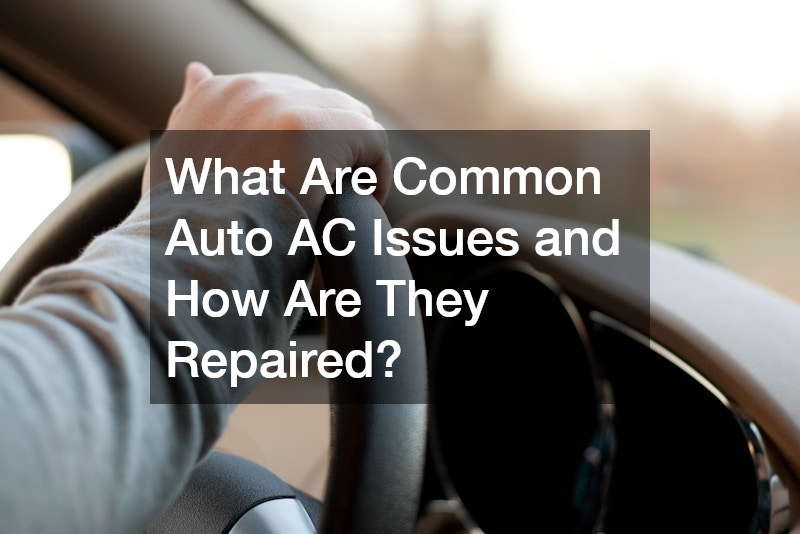Car repairs can be intimidating, especially if you don’t have a background in automotive issues. Whether it’s dealing with strange noises, dashboard warning lights, or sudden performance issues, many car owners are unsure when they need to take their vehicles in for a repair. This article aims to answer some of the most common FAQs about car repairs, providing clarity on when and how to seek help from professionals. Understanding how auto mechanics work, what services auto body shops provide, and the differences between local auto repair shops and specialized services can help you navigate these situations with ease.
Keeping your car in good condition is essential not just for ensuring its longevity, but also for avoiding expensive repairs down the road. Routine maintenance and addressing small issues early on can prevent costly repairs that may arise if problems are left unchecked. Throughout this article, we’ll explore common automotive concerns and provide practical advice on how to handle them. From understanding auto repairs to knowing when to seek brake repairs or auto AC repairs, you’ll be well-equipped to take on car maintenance with confidence.
When Should I Take My Car to an Auto Mechanic?

Signs Your Car Needs Attention
There are several signs that indicate it’s time to take your vehicle to a professional auto mechanic. One of the most common signs is unusual noises. These could include squealing, grinding, or rattling sounds that seem out of place. These noises often point to worn-out brake pads or issues with other mechanical components like belts or bearings.
Another indicator is the appearance of warning lights on your dashboard. For instance, the Check Engine light can signal a variety of problems ranging from minor issues like a loose gas cap to more serious concerns like engine misfire or transmission failure. Ignoring such lights can lead to further damage, so it’s important to address them promptly.
If you notice reduced performance—such as difficulty accelerating, stalling, or inconsistent power—it’s also time to visit an auto mechanic. These issues could be signs of engine or fuel system problems that need professional attention.
How to Choose the Right Auto Mechanic
Choosing the right auto mechanic can be a daunting task, but there are steps you can take to find the best professional for your needs. First, look for mechanics who are certified, such as those with ASE (Automotive Service Excellence) certification. This certification ensures that the mechanic has undergone the necessary training and has a proven track record of quality repairs.
It’s also helpful to ask for recommendations or check online reviews for local auto repair shops. A mechanic who comes highly recommended from friends or family members is often a reliable choice. Reviews from past customers can give you insight into their work quality, customer service, and overall professionalism.
Benefits of Timely Repairs
Taking your car in for an automotive repair as soon as you notice issues can save you money in the long run. Small problems, such as a squeaky brake or a minor engine misfire, can turn into costly repairs if left unattended. Timely auto repairs prevent these issues from becoming more significant, more expensive problems down the road.
Additionally, addressing minor issues helps you avoid further damage. For example, ignoring a small coolant leak may cause the engine to overheat, resulting in a much more expensive repair. Timely repairs also ensure that your vehicle continues to operate safely, providing peace of mind for you and your passengers.
What is the Difference Between an Auto Body Shop and a Local Auto Repair Shop?
Definition of an Auto Body Shop
An auto body shop is a facility that specializes in the repair and restoration of a vehicle’s exterior. Auto body shops are experts in fixing dents, scratches, fender benders, and other cosmetic damage. They are equipped with tools and technology to perform larger structural repairs, such as straightening the frame or replacing body panels.
If your car has been involved in a collision or has cosmetic damage, an auto body shop is your go-to location. These shops can help restore the aesthetic appeal and structural integrity of your vehicle, ensuring it looks and drives like new.
What Local Auto Repair Shops Handle
On the other hand, local auto repair shops focus on mechanical and electrical issues. They deal with a wide variety of problems, including engine repairs, transmission issues, and brake repairs. Routine maintenance services like oil changes, tire rotations, and battery replacements are also commonly performed at local auto repair shops.
If you’re experiencing issues with your engine, transmission, brakes, or need services such as auto alignments or auto AC repairs, a local auto repair shop is the place to go. They focus on the internal workings of your vehicle, addressing functional problems that impact its performance.
How to Choose Between the Two
Understanding when to visit an auto body shop versus a local auto repair shop can save you time and money. If your vehicle’s issue is related to its appearance or bodywork, such as fixing a dent or replacing a bumper, then an auto body shop is the right choice. However, if your car is experiencing mechanical or electrical issues, you should seek the services of a local auto repair shop.
For example, if your car is making strange noises when braking, it’s likely time for brake repairs at a local auto repair shop. If you’ve been in a minor accident and need to repair a dent, an auto body shop would be the appropriate place.
How Can I Identify the Right Local Auto Repair Shop for My Car?

Reputation and Reviews
When searching for a local auto repair shop, reputation is key. Start by checking online reviews on platforms like Google or Yelp. Customer feedback can give you a sense of the shop’s quality of service, pricing, and overall reliability. You can also ask friends and family for recommendations, as they may have had positive experiences with trusted mechanics.
Additionally, look for shops that are certified by organizations like ASE (Automotive Service Excellence). Certification is a good indicator that the shop’s technicians are skilled and knowledgeable in auto repairs.
Range of Services
Not all auto repair shops offer the same range of services. It’s important to choose a shop that provides the specific services your vehicle needs. For instance, if you’re dealing with auto alignments, brake repairs, or auto AC repairs, make sure the shop has the equipment and expertise to handle these repairs.
A reputable shop will clearly outline its services on its website or in person. It’s important to confirm that they are capable of performing both routine maintenance and more complex repairs. Look for shops that specialize in the types of repairs you anticipate needing.
What Are the Most Common Types of Auto Repairs?
Brake Repairs
One of the most common types of auto repairs involves brake repairs. The brake system is essential for vehicle safety, so it’s crucial to maintain it properly. Over time, components like brake pads, rotors, and calipers wear down and need to be replaced.
If you hear squeaking or grinding sounds when applying the brakes, it’s a sign that your brake pads may be worn. Reduced stopping power is another indicator that your brake system needs attention. Regular brake inspections can help ensure that your vehicle remains safe and functional.
Auto AC Repairs
Auto AC systems are another area that often requires repair, especially during hot summer months. Common issues include weak airflow, hot air blowing instead of cold, or strange smells coming from the vents. These problems are typically caused by issues with the compressor, condenser, or refrigerant levels.
Auto Alignments
Auto alignments are essential for ensuring that your car handles correctly and that tire wear is even. Misaligned wheels can cause your car to pull to one side or make the steering wheel vibrate. If you notice any of these symptoms, it’s time for an alignment.
Regular alignments help maintain optimal tire performance and improve fuel efficiency. If you drive frequently on rough roads or hit a curb, it’s important to check the alignment regularly to avoid uneven tire wear and unnecessary strain on your vehicle.
What Should I Expect During an Auto Repair Appointment?
The Process of Scheduling an Appointment
Scheduling an appointment at a local auto repair shop is simple, whether you do it online or over the phone. You’ll need to provide information such as your vehicle’s make, model, and any symptoms you’ve noticed. It’s also helpful to mention any past repair history, as this can give the mechanic a clearer picture of your car’s needs.
Once your appointment is scheduled, you can expect to drop off your vehicle at the agreed-upon time. Some shops may offer courtesy vehicles or shuttle services if you need to leave your car for a longer period.
Final Inspection and Repair
Once the diagnosis is complete and you’ve approved the repairs, the mechanic will begin working on your vehicle. After the repair, they’ll perform a final inspection to ensure everything is functioning correctly. You may also be given a chance to test-drive the vehicle to confirm that the problem has been resolved.
How Do I Know If My Car Needs Brake Repairs?
Signs You Need Brake Repairs
Brakes are one of the most crucial safety components of your vehicle. If you notice any of the following signs, it’s important to address potential brake issues immediately to avoid dangerous situations:
- Squeaking or Grinding Noises: If you hear a high-pitched squeak or a grinding noise when you apply the brakes, it usually indicates that the brake pads are worn down. The metal parts of the braking system may be rubbing together, which could cause further damage to your brake components.
- Vibrations or Shaking: If the brake pedal or steering wheel shakes when you press the brakes, it could indicate warped rotors. This issue may cause uneven braking and longer stopping distances.
- Reduced Stopping Power: If your vehicle is taking longer to stop, or if the brake pedal feels soft or spongy when you press it, it may be a sign of air in the brake lines or a problem with the brake fluid.
- Pulling to One Side: If your car pulls to one side when braking, it could be due to uneven brake pad wear or an issue with the brake calipers. This can affect the car’s handling and safety.
If you notice any of these signs, it’s important to have your brakes inspected and repaired by a professional mechanic as soon as possible.
What’s Involved in Brake Repairs?
Brake repairs typically involve inspecting and replacing worn brake pads, rotors, and calipers. In some cases, the brake fluid may need to be flushed and replaced if it’s contaminated. A mechanic will inspect the entire braking system to identify the cause of the problem and recommend the appropriate repairs.
Regular brake maintenance can help prevent these issues. It’s recommended to have your brakes checked every 12,000 miles (approximately once a year) or more often if you drive in harsh conditions, such as stop-and-go traffic or mountainous terrain.
What Are Common Auto AC Issues and How Are They Repaired?

Signs of Auto AC Problems
Auto air conditioning systems provide comfort during hot weather, but they can experience issues over time. Here are some common signs that your AC might need repairs:
- Weak Airflow: If the airflow from your air conditioning system seems weak or barely noticeable, the issue could be due to a clogged air filter or a problem with the blower motor.
- Warm Air: If your air conditioning system blows warm air instead of cool air, it could be caused by a refrigerant leak or a malfunctioning compressor. A lack of refrigerant will prevent the system from cooling properly.
- Unpleasant Odours: Strange smells, such as a musty or mouldy scent, can indicate mould or mildew growth in the air conditioning system. This can be caused by moisture trapped in the system.
- Strange Noises: If you hear grinding or rattling noises when the AC is on, this could indicate a problem with the compressor or other components of the system.
How Are Auto AC Repairs Performed?
Repairs for auto AC systems typically start with a diagnostic check to determine the exact cause of the problem. A mechanic may check the refrigerant levels, inspect the compressor, and examine the condenser for any signs of leaks.
Common repairs include:
- Recharging Refrigerant: If the refrigerant levels are low, a mechanic may recharge the system to restore its cooling capabilities.
- Replacing Faulty Components: If a faulty compressor or condenser is identified, these parts may need to be replaced to restore functionality.
- Cleaning and Sanitising: If there’s a mould or mildew buildup, the system may be cleaned and sanitised to eliminate odours and improve air quality.
Regular maintenance, such as replacing the cabin air filter and ensuring the refrigerant is at proper levels, can help prevent most AC issues.
How Can I Tell if My Car Needs a Tire Alignment?
Signs of Misalignment
Wheel alignment is crucial for ensuring that your tires wear evenly and that your vehicle drives straight. If your car’s alignment is off, you may notice the following signs:
- Vehicle Pulls to One Side: If your car pulls to one side, even when you’re driving on a straight, flat road, it’s a sign that the wheels are misaligned. Misalignment can cause your vehicle to veer left or right, which can be dangerous.
- Uneven Tire Wear: If you notice that your tires are wearing unevenly, particularly on one side, it’s often a sign that the wheels aren’t properly aligned. This uneven wear can lead to premature tire replacement and decreased performance.
- Steering Wheel Vibration: A misaligned vehicle can cause the steering wheel to vibrate, especially at higher speeds. This is due to the uneven distribution of pressure on the tires caused by misalignment.
- Crooked Steering Wheel: If your steering wheel isn’t centred when driving straight, it’s a clear indicator of misalignment. This can make your driving experience less comfortable and potentially unsafe.
The Alignment Process
During a wheel alignment, the mechanic will adjust the angles of the wheels to ensure they are set to the manufacturer’s specifications. This process involves measuring the toe, camber, and caster angles of the wheels and making adjustments as needed.
Wheel alignments are generally needed every 10,000 to 12,000 miles or if you’ve recently had a collision or driven over a large pothole.
How Much Do Car Repairs Typically Cost?
Understanding Car Repair Costs
Car repair costs can vary widely depending on the type of repair, the make and model of the vehicle, and the region where you live. Generally, the more complex the repair, the higher the cost. Routine maintenance like oil changes or brake pad replacements are relatively inexpensive compared to major repairs like transmission or engine replacements.
Here are some typical cost ranges for common repairs:
- Oil Change: $30 to $100
- Brake Pad Replacement: $150 to $300 per axle
- Auto AC Repair: $100 to $1,000 (depending on the problem)
- Tire Alignment: $75 to $100
- Engine Repair: $500 to $4,000 or more
- Transmission Repair: $1,000 to $3,500 or more
Keep in mind that labor costs typically make up a significant portion of the repair costs. Labour rates vary depending on the location and the skill level of the mechanic, and they can range from $50 to $150 per hour.
How to Save Money on Car Repairs
To save money on car repairs, consider the following tips:
- Routine Maintenance: Keeping up with routine maintenance, such as oil changes and tire rotations, can prevent major issues from developing.
- Get Multiple Quotes: Don’t hesitate to get quotes from different repair shops. Prices can vary, and some shops may offer discounts or loyalty programs.
- DIY Repairs: If you have the necessary skills and tools, some minor repairs—like replacing air filters or changing oil—can be done at home to save on labour costs.
- Choose Aftermarket Parts: Aftermarket parts can be less expensive than OEM (original equipment manufacturer) parts and are often just as effective.
What Should I Do if My Car Breaks Down on the Road?
Immediate Steps to Take
If your car breaks down while you’re on the road, follow these steps to stay safe and get assistance:
- Pull Over Safely: As soon as you notice an issue, pull over to the side of the road or a safe area away from traffic. Turn on your hazard lights to alert other drivers.
- Assess the Situation: Try to determine the cause of the breakdown. If you’re familiar with the vehicle’s symptoms (such as overheating or a flat tire), it may be possible to make a quick fix. However, if you’re unsure, it’s safer to wait for professional help.
- Call for Assistance: If the problem is something that can’t be easily fixed on the spot, call for roadside assistance. Many insurance policies offer roadside assistance, or you can contact a towing company to take your car to the nearest mechanic.
- Stay Safe: If you’re stranded on a busy road, it’s important to stay inside your vehicle unless it’s absolutely necessary to exit. If you need to get out, be sure to do so from the passenger side to avoid traffic.
Preventing Breakdowns
The best way to avoid a breakdown is by keeping up with regular maintenance and addressing any issues as soon as they arise. Regular inspections of your vehicle’s fluid levels, battery, tires, and engine can help identify potential problems before they cause a breakdown.
Conclusion
Car repairs don’t have to be overwhelming. By being aware of the common issues, knowing when to visit an auto mechanic, and understanding the difference between auto body shops and local repair shops, you can navigate the repair process with confidence. Be proactive about regular maintenance and address problems early on to avoid costly repairs in the future. The key to keeping your vehicle running smoothly lies in finding reliable, qualified mechanics and establishing a relationship with a trustworthy local auto repair shop.
Whether you’re in need of simple maintenance, major repairs, or specialized services, understanding how to approach car repairs will ensure that your vehicle stays in top shape for years to come.
